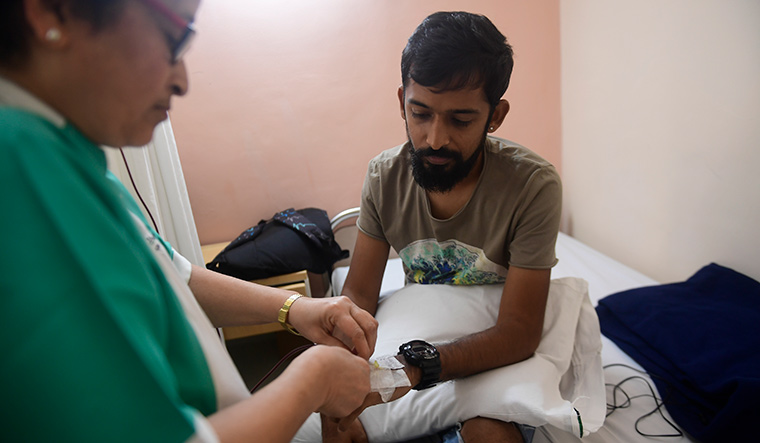VARUN AHUJA, in faded blue denims, a jacket and brown sports shoes, sits patiently at the edge of bed number 1 in the second-floor ward of Mumbai's S.L. Raheja Fortis Hospital's Thalassemia Centre, texting on his phone. He has a scrawny physique, bright eyes, a well-groomed beard and hair that is neatly pulled back with gel. At first, it seems as if he is a visitor, but then a nurse enters the room with two bags of blood, sets them up on the stand next to his bed, asks him to extend his arm and injects the IV drip. The blood begins to flow into his veins. This happens twice a month.
Ahuja is a patient of beta thalassaemia, a genetic blood disorder in which the body's capacity to produce haemoglobin is severely restricted. This leads to a severe lack of oxygen in many parts of the body and the patient requires constant replenishment of red blood cells to keep him alive. Ahuja was diagnosed with it when he was all of six months.
He arrives at the hospital at 9:30am and leaves at around 4pm. He gets two fresh pints of blood and, by way of it, also a large amount of iron that builds up in the liver, heart and other organs, potentially leading to eventual damage. “Each time I come for a transfusion, I end up spending almost seven or eight hours [at the hospital], which means I have to do a lot of work to fit it into my schedule,” says the event manager and travel consultant who has 22 blood donors on his list. “Also, on some days, I am given several pre-meds (premedication), which makes me drowsy and keeps me from eating or functioning properly for basically the entire day.”
Apart from his transfusions, Ahuja has to take 10 tablets a day (Kelfer, 500mg) to contain the iron overload in his body. “Every night, throughout my school years, I would prick my tummy with this injection that would stay there for the next twelve hours,” he says. “It was really killing me. I remember I never slept on my chest as a child. I am sure I will not be able to do it now.”
But Ahuja, an adrenaline junkie, knows the transfusions are now part of his life. “I have done everything, from scuba diving to bungee jumping to sky diving to racing fast cars,” he says. “But I do feel fatigued at times, and also frustrated for being severely restricted in terms of my travel and my intake of iron-rich foods, especially red meat. I wish there was an end to this.”
He vows to not marry before testing his partner for thalassaemia, because if both are carriers of the disease, their child, too, would be a thalassaemia major, as had happened to him.
However, with the advent of CRISPR/Cas9, a gene-editing tool, scientists are working on the possibilities of treating thalassaemia in a new way. “As of now there is no actual cure for thalassaemia apart from highly expensive bone-marrow transplantation, which is not practical for the lack of matching donors and its huge cost,” says Dr Sudeep Gupta, director, Tata Memorial Centre Advanced Centre for Treatment, Research and Education in Cancer, in Kharghar, Navi Mumbai. “But CRISPR is very promising. The thing is that it can snip out a targeted faulty gene mutation (one that leads to thalassaemia) and replace it with a normal one. We are still at the research stages, but if successful, it will hopefully rid a thalassaemia patient of all the fatigue associated with injections, transfusions and drug treatments.”
However, it will be long before the technology is, if ever, put into use. Says Dr Sunil Parekh, senior haematologist at S.L. Raheja Fortis Hospital, who has been treating Ahuja since childhood: “I believe that young patients must now take some precautions, for example, unmarried people should do the blood test so that they can know about their carrier status and avoid marrying the carrier of the disease. Also, consanguineous marriage should be avoided.”


